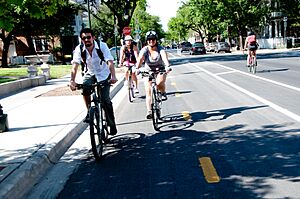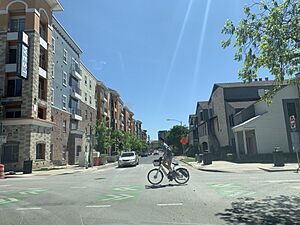West Campus, Austin, Texas facts for kids
West Campus, sometimes called "Wampus" by students, is a lively neighborhood in central Austin, Texas. It's located just west of Guadalupe Street, also known as "The Drag," and is very close to the University of Texas at Austin. Because it's so near the university, many college students live here.
Contents
History of West Campus
From Wheatville to Student Hub
West Campus was once home to a community called Wheatville. This was Austin's first Black community after the Civil War. It was started in 1867 by James Wheat. Wheatville was a strong, self-sufficient neighborhood. It stretched from what is now 24th Street to 26th Street. Shoal Creek was to its west, and Rio Grande Street was to its east.
However, by the early 1900s, Wheatville began to shrink. The city of Austin made a plan in 1928 that unfairly separated people. This plan meant that Wheatville did not get important services. Things like trash collection, electricity, paved roads, and water were not provided. Even though a city trash dump was in Wheatville, residents did not get regular trash pickup. City garbage trucks often left trash right on the streets.
These unfair actions, along with more students moving in and rising property costs, made many Black residents leave Wheatville. They looked for better places to live, especially in East Austin. By the mid-1930s, the busy community had mostly disappeared. Some old buildings, like the Franzetti building, still stand. The Wheatsville Co-op grocery store also honors its history.
Growth for University Students
Later, in the 1930s, West Campus became a popular place for students. A new law called the National Housing Act helped. This law encouraged building new homes during the Great Depression. At the same time, more students were coming to the University of Texas (UT) in Austin. This made developers want to build in West Campus.
After World War II, even more students came to UT Austin. This was because of the G.I. Bill. This bill helped soldiers go to college. To meet the need for student homes, private builders changed single-family houses into bigger apartment buildings. In 1958, the Austin Plan changed the rules for the area. This allowed for many apartment buildings to be built, leading to fast growth.
West Campus kept growing throughout the 1900s. It became a popular place for real estate. In 2004, the University Neighborhood Overlay (UNO) plan started. This plan aimed to improve the area. It encouraged builders to include a small number of affordable homes. In return, they could build tall buildings. Since 2005, UNO has helped build many new homes. These include over 5,000 units and 12,000 bedrooms.
New rules in the mid-2000s also helped bring more students to the area. This led to many new apartment and condo projects. Between 2004 and 2009, about 2,400 new homes were built.
In 2020, people voted for Project Connect. This plan will add new public transportation lines. These include two light rail lines and three bus lines. The Blue Line and Orange Line will run along Guadalupe Street. This street is right next to West Campus.
University of Texas at Austin Connection
The UNO Plan and Student Housing
The biggest changes in West Campus recently are thanks to the University Neighborhood Overlay (UNO) Plan. This city plan started in 2004. The UNO plans were made to create a living area close to the university. It helps bring student housing together in one place. This also means fewer students have to drive to campus from far away. It also helps with parking around West Campus.
The plan wanted to bring UT students closer to campus. It also aimed to create a more urban area with more buildings. This would provide more space for the growing number of students.
Nearby Attractions
Because West Campus is so close to the university, it's near many cool places. These include the Blanton Museum of Art and the Harry Ransom Center. The LBJ Library is also nearby. The Bob Bullock Texas State History Museum, which has an IMAX theater, is close too. Pease Park is on the western edge of the neighborhood.
Cityscape of West Campus
West Campus is a mix of different smaller neighborhoods. It is generally bordered by West 29th Street, Guadalupe Street, North Lamar Boulevard, and Martin Luther King Jr. Boulevard. Areas west of San Gabriel Street often have single-family houses. The parts closer to the University of Texas at Austin are more for students. Many houses here are bungalows.
The eastern edge of West Campus is a busy shopping area called "The Drag" or Guadalupe Street. Here you can find clothing stores, restaurants, and bookstores. These shops are right across the street from the university.
Student groups like fraternities and sororities at UT Austin are often found in West Campus. Many small businesses also operate here. The Caswell Heights area is in the southwest part of West Campus.
Several large student housing buildings are in West Campus. These include The Block, The Callaway House, and The Castilian.
West Campus Population
West Campus has one of the highest numbers of people living in a small area in Austin. In 2000, about 10,000 people lived there. By 2009, with all the new apartments, the number grew to over 17,000 residents. As of 2009, many young professionals, university teachers, and retired people also live in West Campus. By 2020, over 30,000 people called West Campus home.
| Race/Ethnicty | Percentage |
|---|---|
| White | 58.99% |
| Black | 8.48% |
| Asian | 13.24% |
| Hawaiian/Pac. Islander | 0.03% |
| Hispanic | 19% |
| Native American | 0.26% |
Housing in West Campus
West Campus has many different kinds of buildings. You can find old mansions, houses, and apartments here. The area is always growing to meet the housing needs of the more than 51,000 college students at UT Austin.
The buildings in West Campus are very diverse. You might see an 80-year-old building right next to a modern apartment complex. There are Craftsman homes, bungalows, historic mansions, duplexes, and both old and new apartments.
This neighborhood is also known for its many student groups and Greek organizations. West Campus is home to over 50 Greek groups. It also has more than 12 co-ops, which are shared living houses. These are organized by the Inter-Cooperative Council (ICC) and College Houses. Many other student organizations are also found here.
Between West Campus and the University of Texas campus is "The Drag." This street is full of restaurants and shops.
Education
The Austin Independent School District runs the public schools in the area.




